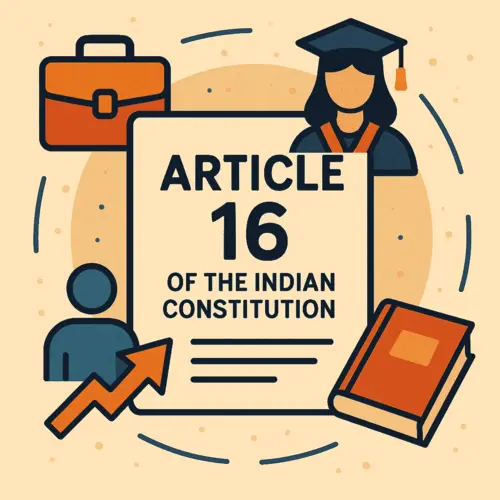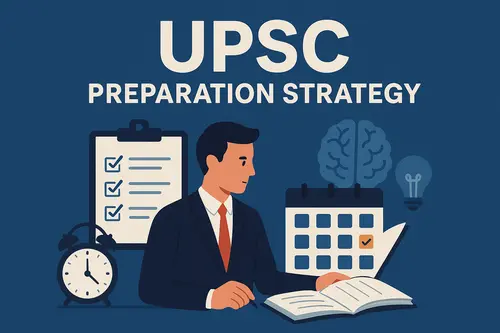
The principle of equality of opportunity is not simply a matter of legal equality. What we are aiming at is real equality of opportunity for all, which cannot be achieved merely by declaring everyone equal.”
— Dr. B.R. Ambedkar, Constituent Assembly Debates, November 30, 1948
Introduction – The Core of Equal Opportunity
“Equality has no meaning if it does not guarantee equal opportunities.”
Article 16 of the Indian Constitution establishes equality of opportunity in public employment and ensures that birth, caste, or wealth do not determine access to government jobs or offices, but ability and merit do.
But this promise enshrined in the Constitution continues to face trials in contemporary India. In Karnataka, a recent caste census has renewed debates about social justice as either an economic need or a caste disadvantage. Also, the state of Telangana decided to extend reservations to 67%, breaking the 50% limit placed by the Supreme Court. The refusal to hear a plea against Telangana’s effort reflects the constant struggle between the limits of the Constitution and changing social circumstances.
From the politics of the Mandal Commission to contemporary caste certificates, Article 16 represents an ongoing tension between meritocracy and equity, and between individual rights and collective justice in everyday life.
Read about Article 15 & Reservations: Click Here
Article 16 – The Constitutional Blueprint
Article 16 of the Constitution of India is titled “Equality of Opportunity in matters of Public Employment.” This section sets out the rules for fairness while permitting the State to also remedy previous inequities.
Clauses (1) & (2): The Equal Opportunity Mandate
- Article 16(1): Provides for equality of opportunity for all citizens in respect of employment or appointment to any office under the State.
- Article 16(2): Prohibits discrimination against any citizens on grounds of religion, race, caste, sex, descent, place of birth, domicile, residence or any of them.
Taken together, these two clauses are the moral backbone of India’s merit-based civil service system — where every citizen starts in principle at the same starting line.
Clauses (3)–(6): Balancing Merit and Justice
- Article 16(3): Allows Parliament to make laws providing for residence requirements in respect of any State post.
- Article 16(4): Enables the State to make provisions for backward classes who are not adequately represented in the services under the State.
- Article 16(4A): (Added by the 77th Amendment, 1995) — Enables reservation in promotions for SCs and STs.
- Article 16(4B): (Added by the 81st Amendment, 2000) — Enables the carry-forward of unfilled reserved vacancies after the 50% ceiling.
- Article 16(6): (Inserted by the 103rd Amendment, 2019) — 10% reservation was created for the Economically Weaker Sections (EWS) of the general category.
These clauses showcase the dynamic and adaptive nature of India’s Constitution — it doesn’t freeze equality in theory, but redefines it in practice as society evolves.
Article 16 is not just a legal safeguard — it’s India’s social equalizer. It embodies the nation’s continuous attempt to walk the fine line between fair competition and fair representation.
The Mandal Moment – Pivotal Time in Indian Reservation Politics
The late 1970s were a defining moment in India’s social justice movement. In 1979, the Mandal Commission (formally known as the Second Backward Classes Commission) was appointed, headed by B.P. Mandal, a visionary from Bihar to establish the degree of social and educational backwardness of classes, and to make recommendations for their uplift.
The Commission undertook an exhaustive survey, and when it concluded, it revealed a startling fact: nearly 52% of our country comprised Other Backward Classes (OBCs). The Commission recommended correcting centuries of discrimination that OBCs faced, and suggested the allocation of 27% reservation in government jobs for OBCs, in addition to Scheduled Castes and Scheduled Tribes quotas.
In 1990, when the V.P. Singh government implemented the Commission’s recommendations, it rocked the nation. Protests erupted across the country, students self-immolated, and merit versus representation became a dividing line across the country. To quell public outrage, the government announced an additional 10% quota for Economically Weaker Sections (EWS) amongst the general category, which was contested in court.
Thus began the Mandal Era, where India’s democracy was confronted with its deepest and most abiding question: what does equality really mean when the society is built on inequality?
Indira Sawhney vs Union of India (1992)
The Indira Sawhney vs Union of India (1992), also known as the Mandal Judgment, remains one of the most impactful judgments in the constitutional history of India. A nine-judge bench of the Supreme Court of India called to determine whether reservations for the Other Backward Classes (OBCs) offended the equality principle. This was a judgment that reshaped the landscape of affirmative action within India.
| Key Issue | Supreme Court’s Ruling |
|---|---|
| Validity of 27% OBC reservation | Upheld (but subject to exclusion of the creamy layer) |
| 10% quota for poor among general category | Struck down as unconstitutional |
| Reservation in promotions | Not allowed under Article 16(4) |
| Reservation limit | Capped at 50%, except in extraordinary circumstances |
It introduced the now-famous Creamy Layer concept, allowing for provisions of reservation to flow to the most marginalized within the OBCs. The judgment also established a limit of 50 percent on total reservations to uphold administrative efficiency and equality of opportunity.
The Indira Sawhney judgment thus became a constitutional lodestar for every future debate on reservations from caste-based reservations to economic ones.
The Constitutional Amendments Quest – Evolving Article 16
The journey of Article 16 did not end with Mandal or Sawhney. Parliament, as society evolved, continued to balance representation, efficiency and equity through a series of constitutional amendments.
77th Constitutional Amendment (1995):
Inserted Article 16(4A) – permitting reservations in promotions for Scheduled Castes (SCs) and Scheduled Tribes (STs) if they were under-represented in the higher services.
81st Constitutional Amendment (2000)
Inserted Article 16(4B) — carried forward unfulfilled reserved vacancies beyond the 50% ceiling, thereby ensuring that a historical backlog would not be lost in bureaucratic ceilings.
103rd Constitutional Amendment (2019)
Added Article 15(6) and Article 16(6) — establishing a 10% reservation for Economically Weaker Sections (EWS), marking a turning point – moving away from caste-based and instead based on income.
While challenged, these reservation measures were ultimately upheld in the case of Janhit Abhiyan v. Union of India (2022), which was decided by the Supreme Court holding the 50% limit was only applicable to caste-based reservations (SC/ST/OBC), and not to the EWS.
Together, these amendments show how Article 16 has been turned into a living, breathing instrument — adaptable to the dynamics of India’s ever-evolving social paradigm, while always keeping its sight on the ultimate objective of inclusion and equality.
Reservation in Promotions – Judicial Adjustment
While Article 16(4A) appeared to create a basis for reservation in promotions, the judiciary played an essential role in defining the extent of what the State could do. In practice, the judiciary became the referee as the Supreme Court attempted to balance social justice against efficiency.
M. Nagaraj vs Union of India (2006): Establishing the Framework
The Supreme Court, in this significant decision, validated reservation in promotions but with some limitations. It directed that the State must establish three things before providing such promotions:
- Unrepresented adequacy of SCs/STs in the superior rank.
- Backwardness of the group.
- Administrative efficiency cannot be sacrificed — merit and governance cannot be compromised.
This ruling emphasized that any affirmative action must be based on evidence, not on sentiment — the State cannot simply conclude backwardness, he must establish it.
Jarnail Singh vs Lachhmi Narain Gupta (2018): Adjusting the Balance
The Supreme Court effectively revisited Nagaraj and released some strings.
It removed the requirement of the State to establish social and educational backwardsness for SC/STs, and recognized that any historic disadvantage on SC/STs are already an established truth.
However, it appended the “creamy layer” principle to SC/STs for promotions nonetheless and ensured that the more disadvantaged ones obtains benefits.
Ultimately, Jarnail Singh redefined the reservation dialogue — amalgamating constitutional empathy with administrative care.
State of Punjab v. Devender Singh (2024): The Revisiting the Caste Census
The recent judgment of this Supreme Court bench has marked a watershed moment. The Supreme Court has permitted the sub-classification of SC/ST groups, thereby reversing the decision in E.V. Chinnaiah (2004).
The Court reasoned that Scheduled Castes are not a monolithic segment – some sub-castes are distinctly more disadvantaged than others. Thus, each state may sub-classify SCs and STs to ensure that the most disadvantaged of a disadvantage receive the benefits of reservation intended to them.
This case once again turned the discussion to the idea of “equity within equality” – a shift from general and broad quotas to more targeted equity, or understanding.
Caste Census and the Future of Reservation Policy
As India’s demographics change, so too does its socio-economic landscape. Without caste data, policymakers are navigating blindly. This led to the renewed discussion of a caste census – the tool to adjust the reservation system in India for the next 100 years.
Census 2011:
- Data meant to measure.
- Demographic data.
- No caste data.
- Specific to SC and ST.
Socio-Economic and Caste Census (SECC) 2011:
Data meant to risk stratify public benefits with caste-based information – test child poverty.
- Caste-based data was never made Census.
- Socio-Economic data was made public.
- State-Level Initiatives:
Bihar (2022-23): Conducted a caste survey of its own, indicating that the population of OBCs and EBCs comprises a total of 63% of the population, and released data about education and income levels in 2023.
Andhra Pradesh (2024): Started a caste survey to inform welfare schemes and reservations.
The National Debate
The demand for a country-wide caste census can be heard more than ever – spread across parties and states. Proponents argue that updated data on caste will:
- Allow reservations to be aligned with likewise population ratios.
- Discover inequities within castes, so reservations can be distributed more equitably.
- Rely on evidence-based policymaking instead of estimates that are decades old.
- Opponents, however, worry it will exacerbate caste divisions and further politicize social identity.
Either way, the caste census debate has brought Article 16 back into the socio-political (and cultural) maelstrom in India.
The Constitutional Network – Articles You Should Know
To fully understand how Article 16 operates, it must be viewed in harmony with a few other crucial constitutional provisions:
| Article | Subject | Significance |
|---|---|---|
| Article 341 | Scheduled Castes | Determined by Presidential Order, after consultation with the Governor of the concerned State. Parliament can later amend this list. |
| Article 342 | Scheduled Tribes | Follows a similar process as Article 341 for SCs. |
| Article 342A | Other Backward Classes (OBCs) | Inserted by the 102nd and 105th Constitutional Amendments; empowers both the Centre and States to maintain separate OBC lists. |
Together, these articles form a constitutional web of inclusion, ensuring that India’s reservation framework remains both flexible and federative — balancing national standards with state-specific realities.
UPSC Relevance of Article 16
| Section | Details |
|---|---|
| Prelims Focus | Key Amendments: 77th (promotion), 81st (backlog vacancies), 103rd (EWS), 105th (state OBC lists) Landmark Judgments: Indira Sawhney (1992), M. Nagaraj (2006), Jarnail Singh (2018), State of Punjab v. Devender Singh (2024) Related Articles: 15, 16, 341, 342, 342A PYQs: “Under which Article can reservation in promotions be made?” (UPSC 2020); “The 103rd Amendment relates to which of the following?” (UPSC 2021) |
| Mains – GS Paper II | Themes & PYQs: “Reservation policies must balance social justice with administrative efficiency.” Role of caste data in policymaking. Ethical debates: meritocracy vs equity. |
| Essay Paper Themes | “Reservation: Means to Equality or Tool of Politics?” “Justice delayed for some is justice denied to all.” |
Conclusion – The Pursuit of Social Justice
Article 16 embodies equality through opportunity. From Mandal to Modern Amendments, it tells a story of a nation where equality of opportunity has evolved from a remedy for exclusion, to a right to representation.
As India struggles with caste census and efficiency, perhaps the viability of equality of opportunity rests on data, dialogue, and the wisdom of the Constitution, all while keeping alive the idea that “equality of opportunity will ultimately succeed where equality of opportunity is guaranteed.”
FAQs on Article 16 & Reservation
It seeks to provide equality of opportunity in respect of public employment, and affirmative actions for sub-communities.
The upper or rich class of backward classes, excluded from reservation.
EWS reservation is based purely on economic basis under Articles 15(6) & 16(6).
The Devender Singh (2024) decision allows state discretion to sub-classify SC/STs, for distribution of benefits.
The last full census of caste was in 1931; SECC data from 2011 has never been published.

